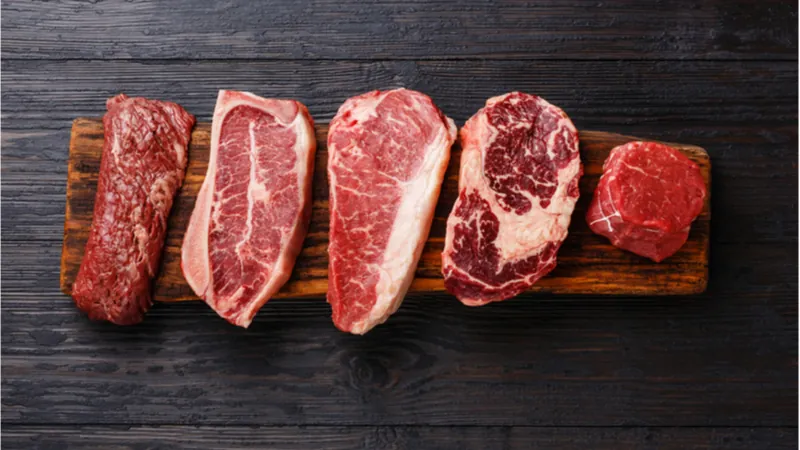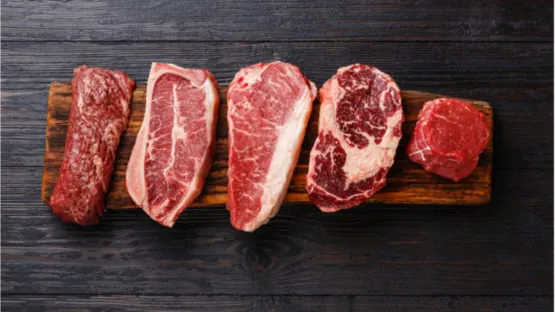Researchers suggest that trimethylamine, a metabolic byproduct that is created when bacteria in the gut break down foods such as red meat, may be a key player in vascular aging.
Trimethylamine and vascular aging
Some researchers believe that trimethylamine damages our arteries, according to a new study conducted by researchers at the University of Colorado Boulder [1]. The researchers suggest that excessive trimethylamine production could be a key risk factor for heart disease.
When we consume foods that contain L-carnitine and choline, the bacteria in our gut quickly break it down into a form ready for the body to consume; however, while doing so, they metabolize it into trimethylamine.
Carnitine is encountered in many animal products, although red meat has the highest known levels. For example, a typical 4-ounce steak has an estimated amount of between 56 and 162 milligrams of carnitine. Carnitine is also present in lower amounts in chicken, milk and other dairy products, fish, beans, and avocado. Choline can be found in fish, beef, chicken and other poultry, eggs, and some beans and nuts.
After the food is broken down, the trimethylamine next reaches the liver, where it is converted into trimethylamine-N-Oxide (TMAO), which then enters the bloodstream and travels around the body. Previous studies have shown that people who have higher blood levels of TMAO are at far greater risk of stroke or heart attack.
The researchers examined the blood and arterial health of 101 older people as well as 22 young adults. They discovered that TMAO levels typically increase with advancing age due to changes to the bacteria in the gut.
This is consistent with other studies showing that the bacterial populations in the gut microbiome change during aging, from being helpful to becoming a more harmful composition as we get older. In this case, the bacteria that produce trimethylamine increase as we age, and thus the level of TMAO in the bloodstream rises.
They found that the adults with high blood levels of TMAO had significantly worse arterial health and function compared to adults with lower amounts. People with higher TMAO in their arteries had increased levels of oxidative stress, inflammation, and tissue damage to the arterial wall lining.
Next, the researchers studied the effects of TMAO on mice, and the results were quite alarming. Mice that were directly given TMAO experienced rapid aging of their blood vessels. Following several months of TMAO supplementation, the 12-month-old mice resembled 27-month-old mice, which is the equivalent of a 35-year-old person looking like an 80-year-old.
There was also some initial data that suggested mice with higher levels of TMAO also experience impaired learning and cognition.
The researchers also report that mice given a compound called dimethyl butanol, which is present in olive oil, vinegar, and red wine, experienced a reduction of vascular dysfunction. This suggests that dimethyl butanol somehow inhibits the creation of TMAO, possibly via the inhibition or slowing of the growth of trimethylamine-producing bacteria populations in the gut microbiome.
The researchers’ next step is to explore other compounds that could potentially reduce the production of TMAO and slow down vascular aging.
Age-related vascular endothelial dysfunction is a major antecedent to cardiovascular diseases. We investigated whether increased circulating levels of the gut microbiome-generated metabolite trimethylamine-N-oxide induces endothelial dysfunction with aging. In healthy humans, plasma trimethylamine-N-oxide was higher in middle-aged/older (64±7 years) versus young (22±2 years) adults (6.5±0.7 versus 1.6±0.2 µmol/L) and inversely related to brachial artery flow-mediated dilation (r2=0.29, P<0.00001). In young mice, 6 months of dietary supplementation with trimethylamine-N-oxide induced an aging-like impairment in carotid artery endothelium-dependent dilation to acetylcholine versus control feeding (peak dilation: 79±3% versus 95±3%, P<0.01). This impairment was accompanied by increased vascular nitrotyrosine, a marker of oxidative stress, and reversed by the superoxide dismutase mimetic 4-hydroxy-2,2,6,6-tetramethylpiperidin-1-oxyl. Trimethylamine-N-oxide supplementation also reduced activation of endothelial nitric oxide synthase and impaired nitric oxide-mediated dilation, as assessed with the nitric oxide synthase inhibitor L-NAME (NG-nitro-L-arginine methyl ester). Acute incubation of carotid arteries with trimethylamine-N-oxide recapitulated these events. Next, treatment with 3,3-dimethyl-1-butanol for 8 to 10 weeks to suppress trimethylamine-N-oxide selectively improved endothelium-dependent dilation in old mice to young levels (peak: 90±2%) by normalizing vascular superoxide production, restoring nitric oxide-mediated dilation, and ameliorating superoxide-related suppression of endothelium-dependent dilation. Lastly, among healthy middle-aged/older adults, higher plasma trimethylamine-N-oxide was associated with greater nitrotyrosine abundance in biopsied endothelial cells, and infusion of the antioxidant ascorbic acid restored flow-mediated dilation to young levels, indicating tonic oxidative stress-related suppression of endothelial function with higher circulating trimethylamine-N-oxide. Using multiple experimental approaches in mice and humans, we demonstrate a clear role of trimethylamine-N-oxide in promoting age-related endothelial dysfunction via oxidative stress, which may have implications for prevention of cardiovascular diseases.
Conclusion
If this connection between excessive TMAO levels and vascular aging turns out to be correct in humans and can be replicated in other independent studies then it suggests a possible therapeautic intervention point. TMAO levels certainly appear to rise as we age as do the populations of bacteria in the microbiome which produce Trimethylamine, so they may be onto something here, though there are likely nuances requiring further study. If TMAO turns out to be a problem as suggested by the researchers approaches that could be potentially developed, such drugs to block its activity or even adjusting the microbiome, could offer a solution to this problem.
Literature
[1] Brunt, V. E., Gioscia-Ryan, R. A., Casso, A. G., VanDongen, N. S., Ziemba, B. P., Sapinsley, Z. J., … & Seals, D. R. (2020). Trimethylamine-N-Oxide Promotes Age-Related Vascular Oxidative Stress and Endothelial Dysfunction in Mice and Healthy Humans. Hypertension, 76(1), 101-112.




